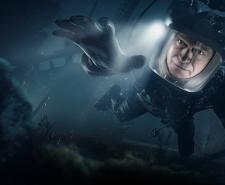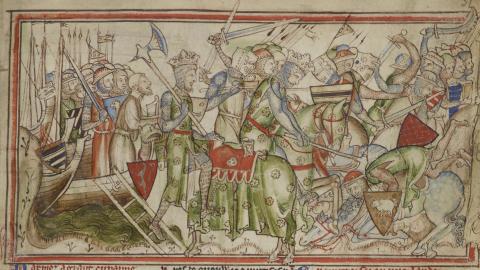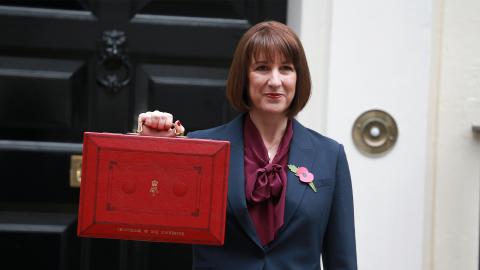
'The jeopardy is always there': Ross Kemp on Deep Sea Treasure Hunter S2
In the second series, Ross is going deeper than ever before and is even venturing outside of the British Isles to explore the remnants of some of the most significant moments in British history.
Image: Ross Kemp Deep Sea Treasure Hunter
Ross Kemp is getting back in the water for a brand new series of Ross Kemp: Deep Sea Treasure Hunter. This time he's going deeper than ever before and is even venturing outside of the British Isles to explore the remnants of some of the most significant moments in British history.
This includes diving on one of the most famous shipwrecks ever discovered, the Mary Rose, to mark the 40th anniversary of the ship being raised.
Sky HISTORY caught up with Ross to learn more about the series, the extra training he had to do and the dangerous situations he found himself in.
Sky HISTORY: With all of the diving experience you gained during the first series, did you find it easier getting back in the water for the second series?
Ross Kemp: There was a bit of a let-off because I was working on other jobs and I didn’t get the opportunity to go into the water. [Dive supervisor] Neil Brock suggested it would be a good idea to go and do some shakedown dives.
So, before we started the series proper, I went to a quarry in Gloucestershire. I went down there, got to 35 metres, did some proper safety stops and got my confidence back.
I was a bit rusty. However, with the amount of training that I had to do to do for the first series, it soon came back to me. I love diving on coral reefs and looking at the flora and fauna, but to be honest, I much prefer diving on a piece of old iron or steel or wood and looking at the history of the vessel, what happened to it and how it ended up on the seabed.
What additional training did you need to complete before you started doing deep sea diving?
To get the deep sea diving qualification takes a lot more training. You start off as an Open Water Diver, then you go to Advanced, then you go to Advanced Rescue. Then to get the HSE (Health and Safety Executive) qualification it was three weeks.
I ended up on my knees on top of a container at 20 metres, calling for bits of scaffolding to be sent down on a bowline while I untied them, constructed a square box of scaffolding, then dissembled it, tied it onto a bowline and sent it back up the rope. I did have a few moments of clarity where I was thinking ‘What am I doing here?’. However, if you can do that then you can probably untangle yourself if you get tangled up inside a wreck.
Then you do a five-hour exam. That was the first time I’ve passed an exam in a very long time, so I was very pleased with myself!
What were some of the biggest challenges you came across while diving for this series?
Visibility is always a major issue. On one of the dives in Normandy, the visibility was so appalling I couldn’t even see my wrist. That’s dangerous because you can lose touch with everybody when the sea is that thick with sea slime.
On the other side of it, when you’re in brilliant visibility like in the Red Sea, you can actually get disoriented. As soon as you jump off the side of the boat you can see the shipwreck below you and it’s a bit like falling off a building. The danger there is that you’ve got to make sure you keep looking at your depth because you can very quickly go below where you’re supposed to.
For example, because I’m talking a lot, I build up a lot of CO2 in my mask and I’m pretty wary of that. Myself and my partner, Mallory [Haas], got a CO2 hit when we were trying to wrestle a bit of lead out of the seabed which made us both pretty sick.
Dry suit diving is more complex than wetsuit diving because you trap air inside the suit that keeps you warm, so as you go down it compresses inside the suit and you might have to pump air in. You’ve got a valve on your chest that’s attached to your tank and as you go up, that air expands the closer you get to the surface, so you have to let the air out of your suit otherwise you go shooting up. That’s not what you want because you run the risk of getting nitrogen in your bones called the bends. However, when we went to the Red Sea, we just wore wetsuits which freed me up a bit.
Diving may appear very easy, but it isn’t, it’s extremely technical. If it goes wrong, it can go seriously wrong.
How much did you enjoy getting out to the Red Sea and diving in the warmer waters?
I absolutely loved it. Not that I don’t love diving in the UK. To dive on the Mary Rose was an honour. We were the first people in 25 years, as far as I know, to be allowed to do that, so that’s a privilege and I’ll cherish that for the rest of my time diving.
But at the same time; warmish waters, clear visibility, no mud and no slime - that's a fun time.
Because of the amount of saline in the water, the wrecks are preserved much better and the coral often acts like a preservative. The wrecks look like the things people put in the bottom of goldfish tanks because they’re so well preserved. That will be the thing that will stay with me about the Red Sea.
Also, I’m diving through an iron hull of an 18th century ship, I’m going over the boiler and I’m just skimming past a lionfish and through a shoal of orange fish. It’s quite a different experience to diving in Plymouth Sound.
The Mary Rose is one of history’s most famous shipwrecks – what were your emotions like when you got the opportunity to explore this wreck and considering so few people get to see it up close?
When we found what he believed to be a bit of the bow cast of the Mary Rose and to hold a piece of wood that hasn’t been touched by a human in 500 years, it's like shaking hands with a ghost. It’s been an incredible privilege to make this series.
You dived in so many amazing locations for this series, but which one was your favourite?
For history and the privilege – the Mary Rose. For the sheer richness of what is on board still – the Thistlegorm. And for the depth and the fact that it was like a ship that should still be on the surface – the Rosalie Moller.
What was the most dangerous situation you found yourself in while diving?
When we got the CO2 hit. Because you’re wearing full face masks it’s very different to wearing a regulator. A regulator will expel all the CO2 that you breathe out, whereas if it gets trapped partially in your mask you have to remember to flush it out. But if you’re under the influence of CO2 you forget things like that. People might say it’s a schoolboy error, but they’re not going down, talking to camera and also trying to pull up pieces of lead that we never should have tried to pull up.
The jeopardy is always there. You don’t have to create it. By the very nature of the fact that you’re working under water and pressure, that can cause issues. It’s always in the back of my mind.
Did you find it easier knowing what to look for on the wrecks in terms of treasure?
It depends on your definition of treasure. For me, holding a piece of the actual bow castle is treasure enough. Mallory did find silver coins at the bottom of Plymouth Sound. That’s real booty.
I didn’t get it when I first started doing this. I didn’t get why anybody would want to go with a metal detector into a muddy field in Suffolk or Norfolk, looking for ancient treasure. But it is an amazing feeling to touch something that’s been used by somebody else hundreds of years ago.
Was it nice to be working with Neil, Mallory, and Mark and teaming up together again?
It’s not like working at all. It’s like meeting up with old friends. The very nature of what I’ve done over the last 20-odd years, working with small, close teams often in hostile environments, makes it a very interesting day in the office. I’ve also worked with very big teams, but my favourite is to get into a vehicle with a cameraman and head off into the yonder.
It's just a really nice bunch of people to be with. Easy-going, but obviously serious when it needs to be serious.
Viewers will be pleased to see your Mum join you again, this time to talk about your grandfather in WWII. What was his story?
My grandfather was very fortunate in many respects. I don’t think he had a particularly brilliant war but at least he wasn’t tortured and he came back in one piece.
He got into the Royal Mechanical Engineers as soon as they were formed. He left home in 1940 and didn’t come back until the latter part of 1946 because he was helping to load tanks onto ships to come back to Britain.
To dive on the Thistlegorm was incredible. To see the type of vehicle that my granddad would’ve driven during the desert campaign of the Second World War and to sit in the cockpit was very much like touching history.
Looking back on series two as a whole, what are you most proud of?
There are so many things, but I’m proud that we're all still talking to each other! The more we do it, the closer we become as a team and that’s lovely. For me, that’s probably the biggest bonus. I enjoy the camaraderie and the tangibility of the history.
I was one of the first people, and I’m not an archaeologist, to dive on the Mary Rose for 25 years. That is an incredible honour. To be given that honour by the Mary Rose Trust would be up there for any diver.
Also, the emotion that I felt at the American cemetery in Normandy will stay with me. The importance of the sacrifice that was made on D-Day, particularly on the first 24 hours of those D-Day landings which changed the course of the war and enabled us to have liberty, should never be forgotten.




















